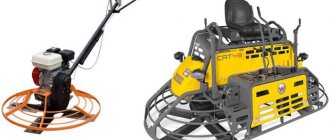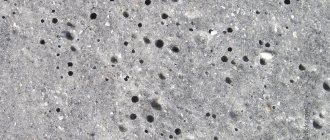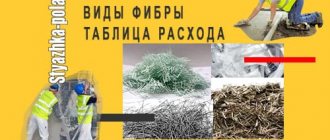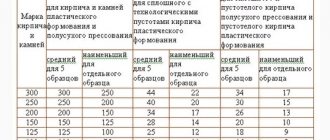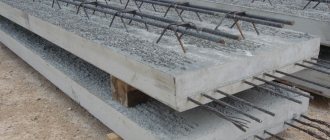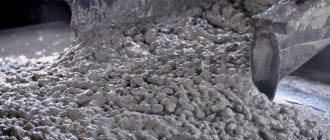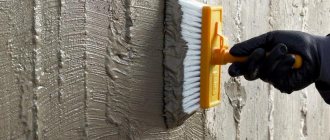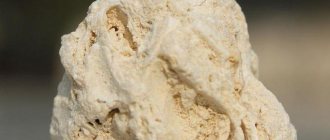A concrete grinding helicopter is a device that allows you to prepare the surface for further work, and in some cases, grouting will be enough to give the desired appearance to the room. This method is considered the most effective for creating a flat floor without drops and cracks.
Source generaltool.ru
What is a helicopter for grinding concrete floors?
Concrete pouring, which has been compacted using vibration devices, after initial drying, urgently needs to bring the surface to its final condition.
Thanks to troweling mechanisms, which are available in various modifications and differ in performance and technical parameters, this can be accomplished quickly. Such devices are used to organize the processing of objects in an individual home or a huge passenger terminal. Mechanized grinding of concrete floors is a highly effective and at the same time economically beneficial activity. A helicopter for grinding concrete floors, used for grouting concrete bases, allows you to easily solve the problem - process a high-quality monolithic structure, ensuring the formation of even, perfectly smooth surfaces. To power the units, several types of power plants are used: they run on diesel fuel, gasoline, or receive power from the electrical network. The “helicopter” structure is as follows:
- platform in the form of a frame structure;
- power point;
- gear unit;
- a working mechanism consisting of blades;
- protective casing;
- equipment controls.
Safety precautions
The key to safe operation of the trowel is strict adherence to safety regulations . The machine operator must constantly be aware of the hazardous production factors that may arise during operation. These are engine heating, carbon monoxide emitted by the power plant, noise during equipment operation, burns from alkalis present in concrete, toxic fuel vapors along with the danger of their fire.
All these factors require increased attention and the use of safe work practices and technologies. They require the operator to use personal protective equipment and special clothing: a work suit made of thick fabric that fits tightly to the worker’s body, safety glasses, ear plugs, closed comfortable shoes with strong toes.
The machine body must have protective guards. Missing any of them can cause serious injury. Do not operate the machine if engine malfunctions are observed . The operator must also maintain a safe distance from moving parts of the equipment. Neither the worker’s legs, nor his arms or hanging items of clothing should fall into the danger zone.
The operator is allowed to work on the trowel only after studying the instructions and safety rules
Types and characteristics
A concrete trowel is a device of simple design: it consists of a drive, a gearbox, a frame, a blade (or two), operator protection and a control system. The surface is rubbed first with a disk that is put on the blades, and then with the blades themselves, which rotate at high speed.
According to the type of drive, a helicopter for grinding concrete can be of the following types: diesel (rather rarely used), gasoline, electric. Fuel-powered devices are mobile and powerful; they can be used in open areas to process large surfaces, but require ventilation indoors. Electric machines can be used in enclosed spaces, but require the ability to connect to the network.
A helicopter for grinding a concrete floor can have a different diameter of the working disk, a different number of rotation speeds, and the angle of the blades can also be adjusted. All models differ in the length of the blades, engine power, and the method of interaction with the operator (a special place or device driven by a person can be equipped for him).
When grinding concrete by helicopter is necessary, when choosing a machine you need to pay attention to the parameters of the unit. Thus, the intensity of the impact on the treated surface depends on the range of rotation. For rough and finishing processing, a unit with a rotation speed of at least 200 rpm is suitable. It is desirable that the rotation speed be regulated.
Diameter is an indicator that indicates the performance of the equipment and the level of maneuverability. If grouting a concrete floor with a helicopter will be carried out in a small room or on shaped areas where there are narrow passages, it is better to choose a diameter of 610 millimeters. When you need fast and effective grouting of a large area, you can take 900 millimeters or more.
Single-rotor
A single-rotor concrete trowel (helicopter) is used to process not very large areas - on average up to 500 square meters. Models can be equipped with a gasoline or electric drive, with one blade with a diameter of up to 1.2 meters. It is possible to adjust the force and speed of rotation.
Double rotor
A two-rotor trowel (helicopter) already belongs to the class of professional equipment, used for processing surfaces of 500 square meters or more. A large-sized productive self-propelled machine can only work in large spaces, without any obstacles or changes in surface configuration.
Models are usually equipped with two troweling blades, the diameter of which is in the range of 600-1200 millimeters. Typically, units run on gasoline or electricity (diesel fuel is rarely used at all, since the operation of the machine is no different from gasoline and this choice is relevant only for those who have free access to diesel fuel).
The devices are controlled by an operator who can sit low or high, usually between the rotors in a special chair. Operates levers, buttons, or joysticks.
Grouting Helicopter for concrete - 2 types of machines for surface grinding
To give monolithic floors high quality, smoothness, evenness, without differences in surface heights, a concrete trowel is used. Special equipment speeds up the finishing process of structures, saving time and physical effort. Along with an improved aesthetic appearance, the products ultimately gain increased wear resistance and performance characteristics.
What is grouting a concrete floor, is it necessary to do it?
The process of creating a concrete floor consists of several operations, and in order to obtain a high-quality, durable and durable coating, it is necessary to follow the technology of performing the work at each stage.
After the required layer of concrete has been applied to the floor and leveled over the surface using a rule, a stage called grouting begins. To understand the role of this stage of work, you need to understand what happens to the concrete after it is applied and leveled.
After applying concrete, the large particles of sand and crushed stone included in its composition are lowered into the lower layers, while the fine fraction and concrete laitance are squeezed up. After the moisture dries, small voids, cracks and irregularities remain on the surface, all of which significantly reduces the strength of the screed and worsens its appearance.
We can only see external imperfections of the surface, but in addition to them, microvoids also appear in the upper layers of concrete, which leads to a decrease in the adhesion strength of sand and crushed stone particles to each other, and this causes peeling of the top layer. As a result of this, significant depressions and potholes soon appear on the surface. Such a floor not only loses its appearance, but also needs to be repaired, which costs additional money and time.
To avoid the described disadvantages, it is necessary to grout the concrete floor; this can be done manually or using special troweling machines.
Purpose of grout
When the concrete screed dries, large elements of sand and gravel sink down, while small ones tend to the surface.
This creates unevenness and voids, and the floor takes on an unattractive appearance. The heterogeneous mass of concrete after drying worsens the quality of the surface. It becomes less durable. The adhesion of material particles is reduced if microvoids appear in the upper layers of the mass. As a result, with regular use, concrete detachments will appear on the surface. This will lead to the appearance of deep depressions. It is possible to repair such potholes, but it will cost a considerable amount. In addition, it is sometimes unrealistic to restore the original strength of the floor.
A concrete trowel can help prevent surface imperfections. When making decisions about using such a machine, it is worth remembering that working with it is quite difficult and requires a certain level of skill. Grouting creates additional compaction of the upper layers of the screed. This increases the strength and wear resistance of the floor. Some craftsmen often use grout mixtures and toppings for high-quality hardening.
Grinding technology
Grinding of concrete is necessary to prevent delamination of the monolith from the effects of cement “military” that occurs on the surface of the structure during vibration compaction. The grinding technology consists in the fact that the working blades of the machine, which rotate frequently, under the influence of rotation speed and vertical load, press the upper layers of pouring into the internal structure of monolithic concrete. The effect is achieved by adjusting the inclined angle of the grinding elements.
Grinding a concrete floor with a self-leveling polymer structure using “helicopters” is prohibited. Material based on polyurethane or epoxy negatively affects the service life of the working parts of devices.
Cost of grouting work
Depending on the purpose, concrete floors bear different operational loads, so the cost of finishing the floor depends on the complexity of its design.
The price of the work consists of the following components:
- Cost of materials. Cheap domestic materials or expensive imported analogues can be used;
- cost of equipment operation;
- the cost of performing the required set of operations. Depends on the initial state of the screed, the hardening option, and the thickness of the concrete layer being removed;
- fare.
Estimated cost of grouting fresh concrete by helicopter:
| the name of the operation | Price per square meter |
| Rough grouting of fresh concrete | from 180 |
| Final grouting of fresh concrete | from 240 |
| Adding quartz topping during grouting (including material cost) | from 220 |
| Adding corundum topping during grouting (including material cost) | from 260 |
| Adding colored topping during grouting (including material cost) | from 320 |
| Applying impregnation to freshly troweled concrete | from 180 |
| Repairing cracks, removing the top layer, sealing cracks with a repair compound, finishing grouting | from 450 |
Grouting a concrete surface by helicopter
When concrete surfaces are grouted, the ceiling and floor treated with a helicopter acquire special decorative and performance properties. They not only become smooth and even, but are significantly compacted, eliminating the appearance of “cement laitance.”
Stages of pouring and grouting concrete mixture.
Grouting of the screed should be done over the entire surface area. The surface, as with manual grouting, must be moistened with water. The junction areas of the screeds should be rubbed down manually. The most favorable period for the procedure is the next day after installation. During the day, the top layer of the screed may not yet gain strength, so all the shortcomings can be corrected quite easily.
What is a concrete helicopter?
Grouting machines are mainly used in large-scale construction. Working with them requires compliance with certain safety regulations.
They can run on either fuel or electricity, but have a common operating principle. The engine rotates a mechanism on which special attachments in the form of blades with replaceable disks, metal or chipboard, are mounted.
Helicopters (or fans) can be single-rotor or double-rotor. They differ in the position of the operator during the grouting process. A single-rotor helicopter is controlled by an operator who stands on his feet and controls the machine using a long handle. The single-rotor mechanism is portable and weighs 30-70 kilograms.
Diagram of a helicopter for grouting/
It performs rough scraping and trowelling of concrete and is used to work on any concrete surface. Its advantages include maneuverability, ease of use and efficiency.
A two-rotor trowel can already be compared to a small car. It weighs a lot. On a twin-rotor helicopter, the operator sits and controls the operation using a steering wheel and several buttons. This mechanism is designed for grouting large areas. This eliminates human contact with the surface being smoothed. The disadvantages of such a machine include excessive cost and poor maneuverability.
Finish stage
After visually determining the readiness of the screed, you can begin finishing grouting. At this stage you need to use a helicopter with blades. Processing is carried out in at least two approaches. Movements during a second pass, as well as during rough grouting, must be perpendicular to the first.
When working with blades, the pressure on the surface increases significantly. Thanks to this, it is easy to achieve high-quality compaction of the mixture. The ability to change the angle of the grout plates allows you to create a mirror-like floor surface.
Also, after the finishing stage using a helicopter, the screed acquires high strength, which is impossible to achieve with hand tools. It is easy to distinguish high-quality work using a screeding helicopter from low-quality work. The surface should be smooth, shiny and even.
How to grout concrete - grouting concrete with a helicopter
When using a helicopter for grouting concrete, it is necessary to scrupulously follow the work technology. Only then is truly excellent grinding quality guaranteed.
Rough grout
Figure 3. Rough grouting of the floor Roughing is carried out using trowel discs, making at least two passes in perpendicular directions. First, surfaces near walls, columns and doorways are treated. Then the trowel disk is placed on the top layer of concrete to compact it: when the unit moves, large fractions of the material move down and are replaced by light components. In order for the cement laitance to emerge, several passes are required. Their number depends only on the thickness of the treated layer and the characteristics of the concrete. We list some features of this processing:
- When a sufficient amount of laitance comes out, it is necessary to apply a topping to the concrete to strengthen the layer. The material is evenly distributed using a special trolley. At the very beginning, approximately 2/3 of this product is applied, then, when the concrete absorbs it and becomes darker, the first pass is performed. After it, scatter the remaining mixture on the floor, again wait a little until the moisture is absorbed. Make a second pass. It is recommended to sprinkle 3–5 kg of topping on each square meter of floor if the expected load on it is insignificant and 5–8 kg if the load is significant.
- It is necessary to accurately select the trowel disc, taking into account the shape of its edge. When the bevel is 45°, the trowelling unit smoothly processes concrete, and at an angle of 90°, the disc is convenient for grinding places where the floor is adjacent to walls or columns.
- After the first pass, performed by a single-rotor machine, they then operate with a unit with two rotors, which is capable of better compacting the mixture of “milk” and topping.
Finish grout
Figure 4. Finishing grouting of a concrete floor The final grinding is performed with a device with two blades in two or more passes, performed in perpendicular directions.
During the first pass, the edges of the blades are placed at a distance from the floor of 7–9 mm, when the second pass is made - 20–23 mm. This allows for better compaction of the mixture; changing the angle allows you to achieve an almost mirror-like surface condition. For finishing grouting, a powerful tool is used, since hand-held “helicopters” are unable to properly grind the surface. A properly polished floor becomes smooth and shiny; there is no need to lay floor coverings on it.
The concrete screed is laid in several stages. At the final stage, you need to grout using trowelling machines for this process. This gives the concrete base excellent performance qualities, making it ready for serious abrasive loads. In addition, the surface after this procedure looks much more attractive.
The price of concrete grouting also depends on how correctly the work is done.
It starts from 150 rubles. per m2
The need for grouting concrete floors
While the poured floor hardens, the largest and heaviest elements of crushed stone go down, and the lightest particles float to the top. But at the same time, peculiar microvoids appear in the upper concrete layers, which is why the particles cannot adhere to each other. When the floor is used, the upper layers peel off, forming impressive potholes on the surface.
To eliminate these shortcomings, expensive repairs will be required. To prevent microvoids from appearing, it is necessary to grout the concrete. After this procedure is completed, the concrete layer on top is compacted, acquiring greater strength and resistance to wear. Experts recommend adding reinforcing substances called toppings when grouting a concrete floor.
Subsequence
Treatment of the concrete surface is carried out in two steps:
1. Rough processing. They start it already 5 hours after pouring. During this period, the concrete is able to harden so that the imprints of human feet remain on it at a depth of no more than 5 mm. At this stage, you need to go through the trowel twice. These must be mutually perpendicular passages.
2. Finishing. This operation can be carried out 13 hours after the completion of rough finishing. To find out whether it is possible to begin the procedure, you need to press your palm to the surface: no marks should be visible on your hand. A concrete floor treated in this way becomes surprisingly smooth and shines like a mirror.
The work is carried out using special tools:
• rotary disk machines - so-called “helicopters”;
• manual or automatic units for applying a strengthening composition;
• specialized devices for working near walls.
Grouting concrete using a “helicopter”
Before grouting concrete with a “helicopter”, it is recommended to wait a certain time for the coating to acquire its original strength. It should harden so much that the depth of the human footprint is no more than three millimeters. Hardening will take from 4 to 20 hours.
Rough grout
This process is most effective when using a machine with trowel discs - a “helicopter”. The procedure is performed in two passes, each of which is perpendicular to the other. Areas of the floor near doorways, walls, columns need to be treated first, because in such places the concrete hardens instantly and there is a risk of being late with grouting.
When grouting with a “helicopter”, rotating discs mix the upper layers of the concrete mixture. When concrete is compacted, crushed stone, which has greater weight and size, rushes down. Light particles such as sand and cement laitance move to the top.
Grout topping
It makes sense to use grout mixtures (topping) to strengthen the surface of concrete floors in warehouses, large industries, commercial centers, parking lots, and market complexes. At these facilities, the floors bear a significant load.
The topping is evenly distributed over the screed using a special trolley.
The following items must be included with the cart:
• convenient container for the mixture;
• augers to grind the stagnant mixture;
• metering valves, with which you can control how evenly the mixture is distributed;
• wheels are wide enough so that a noticeable stripe does not leave a noticeable mark on soft concrete.
Initially, two-thirds of the available topping is distributed. Then you need to wait a while to let the mixture soak in moisture.
You can start treating concrete with a “helicopter” after the grout mixture has darkened. This means that it is sufficiently saturated with moisture. After making the first pass, pour out the remaining topping and leave it to soak again. Then perform a second pass of rough grouting.
The topping consumption is as follows:
• for grouting concrete floors subject to light and medium loads - 3–5 kg/m2;
• for grouting concrete floors experiencing heavy loads - 5 – 8 kg/m2.
The applied composition is mixed with cement laitance using a single-rotor machine with a trowel disk. The correct shape of the edge of the trowel disc is very important. The 45 degree bevel edge allows the concrete surface to be leveled extremely smoothly. For processing areas near walls, door frames and columns, discs with an edge angle of 90 degrees are suitable.
When the grout mixture is evenly mixed, you can begin processing the concrete using a two-rotor disc machine. This powerful device, due to its weight (350–400 kg), is capable of very high quality compaction of a solution of hardener and cement laitance.
To prepare almost all grout mixtures take:
• various high-hardness fillers;
Finish grout
You can tell whether a concrete surface is ready for finishing grouting by eye. Paddle trowels are suitable for finishing. Actions must be performed in at least two passes. In this case, the second of them is performed perpendicular to the first.
The choice of a machine with trowel blades is due to the fact that when it moves along the floor, the specific pressure on the concrete surface increases, which means the quality of compaction of the trowel mixture improves. The trowel blades have a measurable angle, thanks to which the surface of the concrete floor can be processed to an almost mirror-like effect. The quality of the rubbed base is visible by the fact that the surface becomes even, smooth and shiny.
General information
At the moment, this method is considered the most progressive and inexpensive for treating concrete surfaces.
The result is a smooth, durable and dust-free floor that benefits from:
- moderate oil and petrol resistance;
- different color solutions.
A big positive aspect of the technology of grinding with trowels is the receipt of a finished coating simultaneously with the laying of the concrete mixture. This makes it possible to speed up the completion of the construction of the facility and save on finishing coatings. Over large areas, the cost of the effect can amount to more than one million rubles.
Single rotor type concrete trowel
| Application | Experienced builders try to use this technology wherever possible. The process of grouting and grinding a concrete surface with a hardener can be considered universal. For warehouses, industrial premises (workshops) and parking lots, the method is an ideal option. |
| Not applicable | In especially clean laboratory rooms, in areas with aggressive environments and where there are special requirements for the color of the coating. It is not recommended to make concrete floors with grouting and grinding in domestic and residential premises, because they produce “cold”. |
Remember that the technology can only be used on wet concrete. Therefore, take care of preparing the process in advance; you can also find a specialized organization involved in laying concrete floors, or purchase equipment and try to do the grouting yourself.
The main difficulty of the process is grouting and grinding, since it is difficult to predict how the concrete will behave. Therefore, it is important to feel what needs to be done, and this comes with experience.
Disc-blade concrete troweling machine
Use of disc-blade machines
The technology for grouting concrete by helicopter consists of two stages:
- Grout the concrete surface.
- Apply dust-removing strengthening impregnation.
Grouting is necessary to ensure that the concrete “milk”, which protrudes on the surface of the concrete mixture after it has been processed using a vibration-mechanical method, does not peel off during use of the floor. In this case, disc-blade troweling mechanisms or “helicopters” are used. During the work, they compact the concrete surface and bring it to a mirror shine.
Tip: Always have spare equipment when grouting concrete in case the main one fails.
If high demands are placed on the surface in terms of abrasion and strength, a topping is used during grouting - a dry strengthening mixture based on cement. Quartz or other components that have increased abrasion resistance and hardness are also added to the composition.
Grouting a concrete floor manually with a plastic float
At the first stage, a special topping, for example, Refloor RF, must be rubbed into the freshly laid and leveled concrete. On the second step, additionally remove dust with impregnation, which will help stabilize the surface and reduce the formation of cracks to a minimum. It will also chemically bind salts located in the structure of concrete and causing the formation of dust, as a result of which the surface will become dust-free.
Advice: often you are unable to dismantle concrete grooves or structures yourself; in this case, cutting reinforced concrete with diamond wheels is used.
Rough grout
Before starting troweling work on concrete, it is recommended to take a technological break. This will allow the material to gain initial strength. The break time depends on the temperature and humidity of the environment and can be 4-20 hours.
Mechanical application of topping
Usually this is enough for the concrete to set so that when you step on its surface, it will leave a mark 2–3 mm deep. Now you can begin rough grouting the surface of the freshly laid material.
Machine for grouting concrete near walls
It can be done with a disk or trowels with floating blades in 2 passes. The direction of movement during the second pass should be perpendicular to the direction of movement during the first.
Tip: Treat concrete surfaces near columns, holes, doorways and walls first because this is where the mixture hardens first.
Grouting in this case can also be carried out using edge smoothing machines, which are equipped with a freely rotating circle.
When using topping, it is carefully scattered over the surface, achieving a uniform layer thickness. You can do this yourself or use a special trolley for spreading.
Its design is as follows, for:
- there is a container for loading topping;
- grinding the mixture in a container - an auger;
- adjusting the level of crumbling - dispenser valve;
- so that deep marks do not remain on the surface - wide wheels.
Advice: is there a need to manufacture a through channel in reinforced concrete products? Diamond drilling of holes in concrete with the required diameter bits will help you.
Instructions for adding topping:
- At the first stage, add 2/3 of the total consumption per 1 sq. m;
- Apply rough troweling using a concrete smoothing machine. Carry out the process until the topping absorbs moisture from the concrete mixture, which will become noticeable by the darkening of the surface.
- Immediately after this, add the remaining 1/3 parts so that it has time to soak in moisture from the cement laitance before the water evaporates.
- Proceed with the second rough grout as soon as the mixture is saturated with moisture, according to the principle described above.
Tip: instead of purchasing equipment, you can rent concrete trowels.
Most often, a floor with topping can be observed:
- in warehouses where heavy loading and unloading equipment is used;
- in production workshops;
- in markets;
- in shopping centers;
- parking lots;
- at other sites where there is increased pedestrian and traffic load.
Finishing grouting work
During the process of rough grouting, concrete gradually increases its strength. Please take into account that the moment when it is necessary to carry out finishing grouting is determined visually and only a specialist can do this.
Tip: one of the signs is that after grouting with a disc, the surface of the concrete floor looks quite smooth, but the blades of the mechanism do not collect cement “milk” from it.
The process is carried out using the finishing blades of trowels in at least 2 passes. It is best to use equipment that has crossing blades, which greatly facilitates the process.
Bringing the surface to a mirror shine
On each approach, it is necessary to make two passes, and the direction of movement in the second case should be perpendicular to the first. Typically, during the first approach, there should be a distance of 5–10 mm between the edge of the blades and the floor level, and 20–25 mm during the second approach.
This way it is possible to bring the floor surface to a mirror shine. Grout until the material reaches such a level of strength that no marks remain on it.
Advice: for large areas it is better to use double-rotor industrial machines.
conclusions
Modern processing of concrete surfaces using single or double-rotor trowels using strengthening mixtures is the most progressive method, and most importantly the cheapest. After grouting, the concrete surface is strong, smooth and dust-free . It acquires moderate oil and gasoline resistance, as well as various colors.
The great advantage of the concrete grouting technology is that the finished coating is obtained along with laying the concrete. This allows you to significantly reduce the time it takes to put a facility into operation and save on floor coverings. The technology for grouting concrete floors with topping is almost universal and can be used on a wide variety of objects.
The stages and sequence of concrete grouting can be viewed in the video:
Manually
When grouting manually, you will need the following tools:
- Trowel is a type of trowel made of polished steel with a curved handle (can be replaced with a regular spatula). The length of an ordinary trowel does not exceed 22 cm, and the width is 17 cm. The length of the handle varies from 10 to 15 cm. A metal or polyurethane trowel. A rectangular tool with a wooden handle that looks like a plane. Its parameters: 12 by 16 cm. Grater. Narrower than a traditional grater (width is only 5 cm), but longer (20 cm). Container on wheels for even distribution of topping. Board to protect knees.
The procedure for performing manual processing is similar. However, it is worth considering the following features:
It is recommended to apply topping to the surface using a construction sieve, distributing the dry mixture more evenly than mechanically. Instead of a sealing mixture, dry cement or its mixture with sand in equal parts is often used. The screed is grouted manually in a circular motion, working the entire surface until the concrete becomes dark gray, smooth and almost dry. When working, use a popliteal board - an ordinary wooden board - to minimize marks on the surface being treated. After rough processing and applying topping, the finishing stage begins when the compacting mixture on the screed acquires a dark color.
Grouting a concrete floor using floats
Before starting grouting, the beacons (if any) should be removed and the resulting cracks should be sealed with mortar. The process of grouting a concrete floor should begin immediately after the moisture evaporates. To carry out the work, polyurethane trowels are used, which are pressed tightly against the concrete base during the grouting process.
Since in this case a person will have to move on fresh concrete, in order to protect the surface from damage, he should wear special knee pads, which you can buy or make yourself.
After laying the concrete solution, depending on the air temperature and humidity, the grouting process can begin in about 6-8 hours. The process of grouting a concrete floor consists of several stages:
- The topping is evenly applied to the surface. At the same time, it can be applied to a small area manually, but for larger surfaces it will be more reasonable to use a sieve and, moreover, in this case the distribution of the composition over the coating will be more uniform.
- You should wait some time until the applied composition begins to absorb moisture.
- After this, we begin grouting. The readiness of the coating will be indicated by darkening of the applied mixture.
You should start grouting wearing knee pads, which will help leave as few marks as possible on the concrete surface. Using a polyurethane float, rub the mixture into the concrete base in a circular motion. This procedure must be carried out until the surface becomes dark gray. Grouting of a concrete floor must be carried out until the surface is smooth and almost dry. If there are small marks left on the floor from the tool used, they should be cleaned with sandpaper. The concrete floor will dry completely after grouting in about a week and after that it can be used at full capacity or a topcoat can be laid. You will be able to walk on concrete within 24 hours.
Grouting a concrete floor using trowels
Grouting with a trowel over large areas is a rather difficult task, and therefore in such cases special trowels or also called “helicopters” are used.
Depending on the drive (electric or internal combustion engine), helicopters can be divided into dependent and autonomous, and by design they are divided into single-rotor and double-rotor.
Single-rotor trowels are distinguished by lighter weight (30-70 kilograms) and greater mobility. They are controlled using a special handle. Double-rotor devices are heavier units that the operator controls while directly on the machine. Also, in the process of work, wall-mounted devices are used, which are compact and designed for processing hard-to-reach places.
What tools are needed to grout concrete floors with helicopters?
For machining you will need the following tools and equipment:
- Grouting machines.
- Trolley for applying topping (depending on the model, it can be manual or automatic).
- Wall-mounted trowels are used for working near walls and in other inaccessible places.
- Hand floats (with their help it is convenient to eliminate minor defects and grout in inconvenient places).
Types of mixtures used and method of their preparation
You can prepare the grout mixture yourself or use a ready-made compound that is sold in hardware stores.
For grouting with helicopters, it is better to use ready-made mixtures, since in this case the quality of the work performed will be much better.
The grout topping includes the following components:
- High quality cement.
- Pigments and fillers.
- Plasticizers.
There are three types of toppings, each of which has certain qualities:
- Quartz topping. This mixture is the most popular. The reason for this lies in the low cost of the composition. The filler in quartz toppings is perlite, and the desired color is imparted with special pigments. This mixture is best suited for rooms where the floor load is at an average level. For example, they can be used in public and residential buildings. Quartz toppings increase the strength of a concrete screed by one and a half times.
- Corundum mixtures. In this case, the filler is corundum chips, which have fairly high strength indicators, due to which the strength of the floor is doubled. This allows them to be used in rooms with intense floor loads. After grouting, the floor acquires a matte finish.
- Metallized compounds. To prepare such mixtures, metal shavings are used, which, when mixed with cement, give the highest strength indicator. The use of such toppings is advisable in large production workshops, where the floor is subject to heavy loads from large-capacity equipment and strong vibration. Due to the complexity of applying the composition and its high cost, metallized topping is not used for residential and public premises.
Floor grouting using trowels is carried out in several successive stages:
- Initial application of the grout mixture. This procedure should be carried out only after excess moisture from the concrete has evaporated, but the drying process has not yet begun. In this case, about two-thirds of the required composition is applied. To ensure uniform application of the topping, special trolleys are used, after which a leveler can be used for better leveling.
- Rough grout. The procedure is carried out in two passes, perpendicular to each other.
- Reapply topping. At the third stage, all the remaining mixture is evenly distributed over the surface. In this case, the procedure should be carried out immediately after rough grouting. It is important to observe this so that there is still enough moisture left in the concrete to saturate the topping.
- Final grout. Helicopters are used to re-grout the concrete floor. At the same time, you should monitor the uniform movement of the device, since the machines are very powerful and can easily dig deep into the concrete coating, which will lead to damage to the concrete base and additional financial and time costs. To achieve the best result, several passes are performed at this stage and each of them must be perpendicular to the previous one. To achieve a mirror effect, the blades of the trowels are raised and the speed of movement increases.
Characteristics of the equipment used
Before purchasing any tool, every master wants to study all the features and characteristics. But before delving into the intricacies of the equipment, it is recommended that you familiarize yourself with the existing types.
Most often used for grouting:
- Disc machines with gasoline or electric drive.
- Blade units, which are usually called helicopters.
- Equipment with manual and automatic control.
- Edge devices for processing areas near walls.
The helicopter, concrete trowel, can be either single-rotor or double-rotor. Their main difference from each other is the position of the master during use . Single-rotor machines are characterized by control using a rather long handle. The operator moves independently during work. This helicopter is very mobile, its weight varies from 35 to 70 kg. Therefore, the unit can be used on any concrete surface.
A twin-rotor helicopter, on the contrary, weighs quite a lot. It's like a portable car. The master sits on such a machine, controlling it using the steering wheel and buttons.
Such models are suitable for large areas. Their advantage is that the operator does not come into contact with the screed. But there are also disadvantages. These include high price and poor handling.
Edge machines, also called wall-edging machines, can be used not only near walls, but also in corners and other hard-to-reach areas. They have a limited working area in diameter. They work thanks to an electric motor , while energy consumption is low. Popular among domestic models are Caliber, MISOM, COM and TSS, and among imported ones - Zitrek, Grost, Wacker, Neuson and Imer.
Machines are also divided into classes according to the diameter of the working area. Maneuverability and performance depend on it. The standard size of a helicopter is 90 cm. For shaped and small rooms, it is recommended to use machines whose size does not exceed 60 cm.
For finishing grouting, the discs are replaced with blades. They look like plates with a reinforced stiffener. Craftsmen also like to call them trowel knives. This is because they cut off the convex parts of the surface, making it perfectly smooth. You need to choose a model based on your needs. You need to rely on the area of the concrete floor, as well as the number of doorways, corners and columns.

